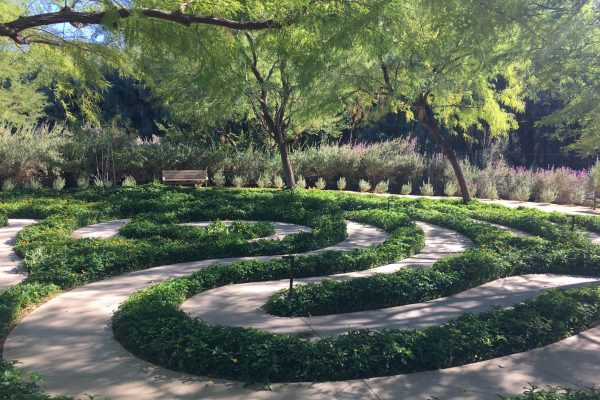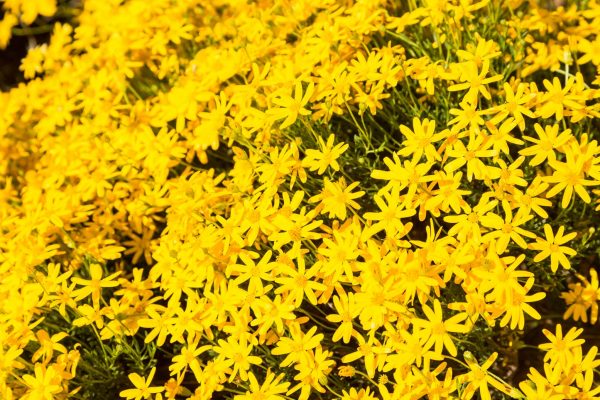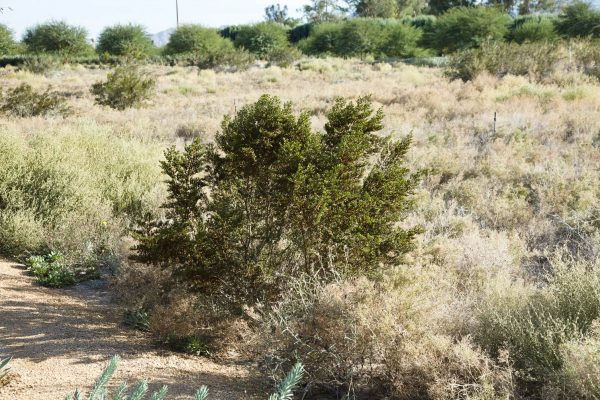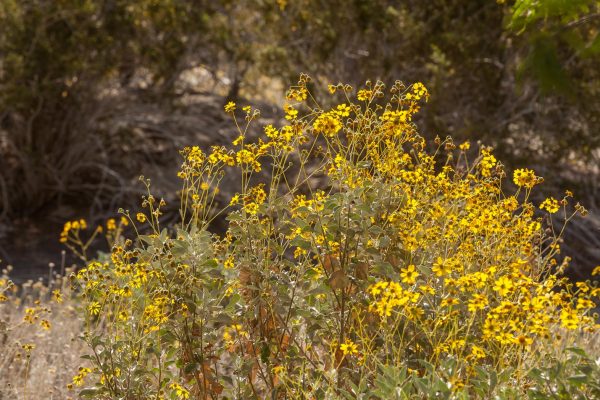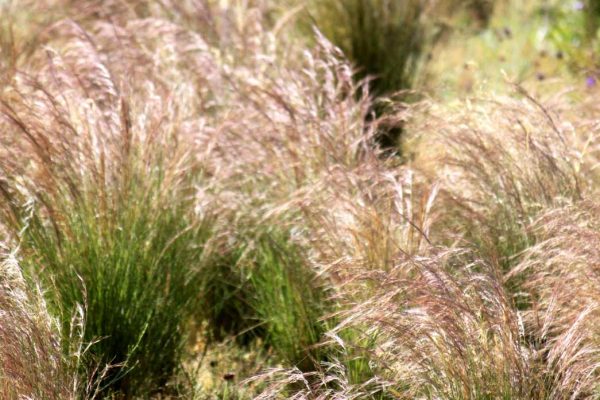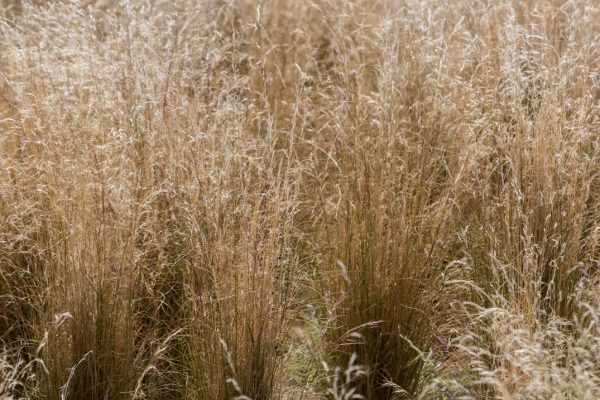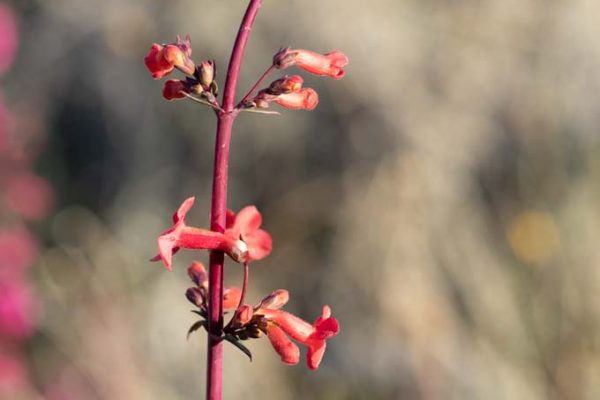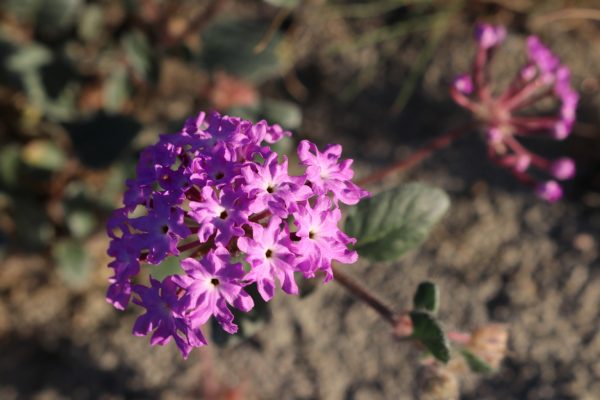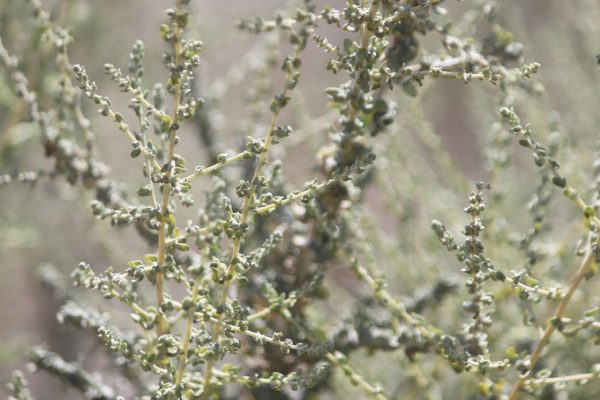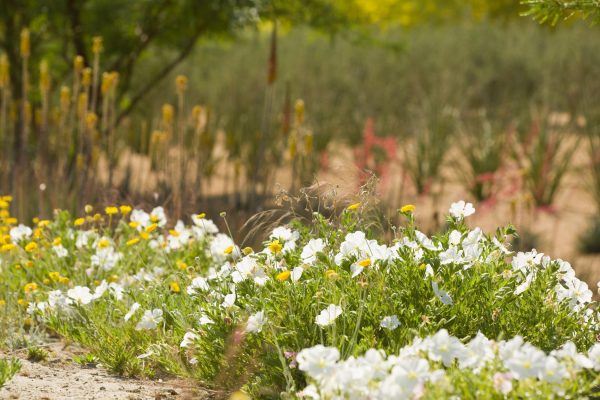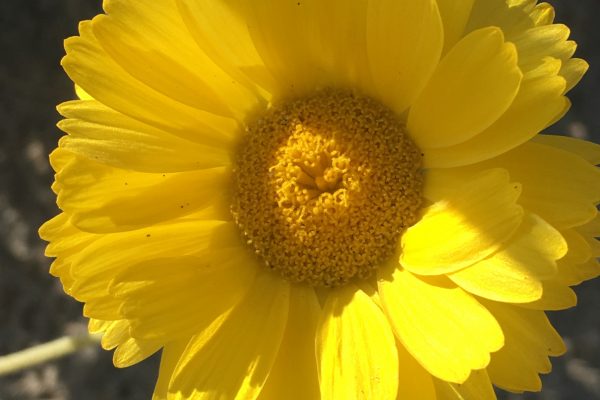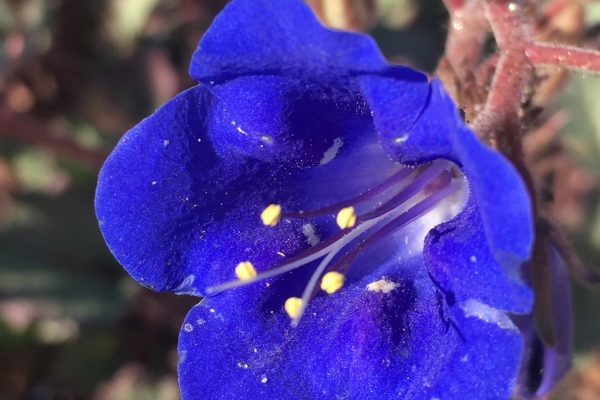Wedelia is the low groundcover that trails around the labyrinth. Its low-spreading nature and deep, glossy green leaves are highlighted by small stems with bright yellow daisy-like flowers.
This is reminiscent of the Angelita Daisy that was the original plant in the labyrinth. It did not do well, and neither did the Trailing Indigo Bush that followed.
The Wedelia seems to be thriving in that space. This exemplifies the multiple micro-climates that can occur in an arid space where differing levels of shade and other ecological challenges can mean the difference between a plant thriving in one spot and declining in another.
Native to Mexico, Central America, and the Caribbean, it is invasive in the neo-tropics.
The ground under the Palo Verde trees that ring the Great Lawn is one of the most challenging parts of the garden to cultivate. Moving from sun to shade around the circle, it’s difficult in the low desert climate to find a groundcover that is consistent from full sun to full shade and meets the color aesthetic required for the gardens.
Prior to Damianita, Green Santolina was in this space but it did not do well. Damianita, though not perfect, has done better. In full sun it thrives and creates a solid mound of yellow, daisy-like flowers on a low-mounding green hedge. The shade is a challenge, and in areas where there is full shade, the blooms are much less. That being said, this trailing species has done well overall and is enjoyed by visitors.
The one species of shrub that was here before Sunnylands was developed and left undisturbed in the wildflower field is Creosote. These are the largest shrubs that you can see in the field with small resinous wax-coated leaves. They have a wet scent reminiscent of rain on the desert.
Native to Mexico, as the climate became warmer and drier, the Creosote moved north, arriving in our area less than 20,000 years ago, which is relatively recent. Since arriving, it has filled a niche with more than 20 species of bees as its major pollinators. It is also food for the Chuckwalla, Desert Iguana, and Black-tailed Jackrabbit, though the jackrabbit will only select Creosote if other more palatable options are not available. The leaves are quite bitter.
There are significant ethnobotanical connections to this plant, and some medicinal uses are being researched today.

Brittlebush, a member of the sunflower family, is a medium desert shrub with fuzzy, silver-green leaves that is common along desert roads and medians. It is an extremely durable desert native. The fuzzy coating on the leaves is a desert adaptation that provides protection from the sun, allows for temperature regulation, and helps capture moisture—a strategy that contributes to its durability. At Sunnylands, it can be found in the wildflower field. The name Brittlebush comes from its stems, which are woody and easily broken. It is easily cultivated, grows quickly, and will expand to about 5 feet in height and can spread its branches to a 5-foot span.
It blooms in late winter and early spring with yellow daisy-like flowers, growing from small stems in clusters that look like they are floating above the leaves.
The range for Brittlebush extends through the Sonora Desert, warmer regions of the Mojave, and in some coastal areas of southern California. In Mexico, it is in Baja California, Baja California Sur, Sonora, Sinaloa, and Hidalgo.
Purple Threeawn is a native perennial bunch grass of North America, but is short lived. It lasts longer than an annual, but not as long as other perennials, depending on care. It spreads by seed and can overwhelm a space if not controlled. It is very drought tolerant.
It has a very soft, feathery look. The stalk is tinted purple and moves in waves in the breeze. It is a striking bunch grass and softens the look of the desert wildflower fields, providing background for wildflowers.
It is native across the southern United States.
Indian ricegrass is a bunch grass, which means it grows as a cluster and is not a spreading grass like turf. It has narrow, rolled leaf blades and is topped with clusters of flowers and seedpods. This cool-season perennial is one of three bunch grasses in the wildflower field that serve as important larval hosts for pollinators, and in sandy soil or scrub, provides stabilization for the sand. It can survive in a variety of habitats and clay soils, although it has a preference for sandy soils. The empty seedpods catch the light and create a glowing effect in bright sun.
The plant is a North American native, with a range extending from southern California up through British Columbia and Alberta and east of the Cascades to Texas and northeastern Mexico.

Found mostly in the Mojave Desert, Desert Penstemon is a robust, blooming plant that never fails to impress. It flowers mainly in reddish pink tones, but cultivated varieties of many colors are in nurseries today. Hummingbirds are attracted to its blooms, and songbirds follow to collect seed. The dried stalks and seed heads rise above the leaf base that can turn to lighter yellows later in season. The stalks can be cut off or left through fall and winter to add interest.
Starting in 2018, Penstemon plants were added to the wildflower field. Originals were transplanted from pots to get them started. They were left to disperse seed, from which additional plants have grown.
The Wildflower Field
The wildflower field at Sunnylands is overseeded annually with native wildflowers and bunch grasses. This provides visitors with a view of the larger cyclical bloom cycles that we have in the desert. Starting in February, a variety of native species and bunch grasses begin emerging. Each year the vegetation varies slightly, depending on which seed dominates the space. The field can range in color from purples to oranges, whites, and pinks, with a variety of combinations. We cannot guarantee that all wildflowers will be present each year.

One of the most familiar desert wildflowers is the Sand Verbena. It is very successful in disturbed areas as well as in dunes and other desert spaces. If heavy rains occur in the months leading up to the bloom season, it is likely that Sand Verbena will dominate the fields and sandy lots throughout the desert. Each plant can expand up to 3 feet and in good seasons create a purple carpet across sandy fields. It is quite often intermixed with Dune Primrose, which is also in the wildflower field.
The name Abronia means “graceful” in Greek and describes the delicate dome-shaped flower clusters. The Abronia villosa will start blooming in spring and at high elevations may continue into June. Sometimes it can begin blooming as early as November.
Western North America is home to all 25 known species of Sand Verbena that range from coastal to desert sand dune ecosystems, including washes and coastal dunes. They can grow in other habitats, but these are primary.
The Wildflower Field
The wildflower field at Sunnylands is overseeded annually with native wildflowers and bunch grasses. This provides visitors with a view of the larger cyclical bloom cycles that we have in the desert. Starting in February, a variety of native species and bunch grasses begin emerging. Each year the vegetation varies slightly, depending on which seed dominates the space. The field can range in color from purples to oranges, whites, and pinks, with a variety of combinations. We cannot guarantee that all wildflowers will be present each year.
This desert shrub is widespread in desert habitats and does best in alkaline plains. Salt Bush can tolerate soil conditions that other desert natives cannot. It does well with Creosote, but is sometimes found in pure stands with few to no other species. It has a unique adaptation to eliminate the high salt content in desert soil. The hairs on the leaves excrete the salts onto the plant surface. This not only removes the salt from within the plant, but the excreted salt then creates a sunblock on the plant surface. It gives Salt Bush a gray appearance.
It blooms with clusters of cream-colored flowers. This is one plant that requires both a male and female plant for pollination.
It is native to the southwestern United States and northern Mexico.

Desert Primrose, like the purple Sand Verbena with which it shares its dunes, is one of the more identifiable wildflowers of the Colorado Desert (the desert that encompasses the Coachella Valley). Desert Primrose comes up in spring to add soft, white cup-shaped blooms among the clusters of purple verbena. It can be surprising to see such a delicate looking flower in the desert’s harsh climate.
The blooms open at night and are gone by the following midday. During this period, it is pollinated by the White-lined Sphinx Moth (Hyles lineata). These moths have a unique flight pattern that resembles hummingbirds. In fact, they are sometimes confused with hummingbirds. Once pollinated, the Primrose will set seed. When it has completed its cycle, the stems will grow up and as they dry out, their tips will meet at the top, forming what looks like a birdcage. This has given the plant its additional nickname, Birdcage.
The Wildflower Field
The wildflower field at Sunnylands is overseeded annually with native wildflowers and bunch grasses. This provides visitors with a view of the larger cyclical bloom cycles that we have in the desert. Starting in February, a variety of native species and bunch grasses begin emerging. Each year the vegetation varies slightly, depending on which seed dominates the space. The field can range in color from purples to oranges, whites, and pinks, with a variety of combinations. We cannot guarantee that all wildflowers will be present each year.

Desert Marigold is a prolific bloomer in the wildflower field. At least one of the plants appears to be blooming at all times. The largest blooming occurs in spring and summer. Desert Marigold’s common name is slightly misleading as it is not related to what is now categorized as true marigolds, those in the genus Tegetes.
Desert Marigold forms small clumps of bright green leaves and sends stalks up above the clump that produce bright yellow daisy-like blooms. When planted in mass, it provides a gorgeous groundcover. There is more than one species of Baileya, but the species in the wildflower field is multiradiata, which means its blooms are arranged symmetrically. This arrangement creates the appearance of the blooms being perfectly round.
This is a North American native that is found in northern Mexico in the states of Sonora, Chihuahua, Coahuila, Durango, and Aguascalientes. In the United States it is native to California, Arizona, Nevada, Utah, New Mexico, and Texas.
The Wildflower Field
The wildflower field at Sunnylands is overseeded annually with native wildflowers and bunch grasses. This provides visitors with a view of the larger cyclical bloom cycles that we have in the desert. Starting in February, a variety of native species and bunch grasses begin emerging. Each year the vegetation varies slightly, depending on which seed dominates the space. The field can range in color from purples to oranges, whites, and pinks, with a variety of combinations. We cannot guarantee that all wildflowers will be present each year.

Desert Canterbury Bells was added to the seed mix in 2013, the year after the gardens were installed. A visitor favorite, it has a tall stalk and a bloom that curves away from the stem like a bright blue bell. As a desert annual, it appears between February and April during the Spring bloom. It flowers, disperses seeds, and dies. The seeds that it disperses can either bloom the following year or, in a unique pattern of desert wildflowers, can wait several years for the perfect moment and conditions to germinate. With a preference for good drainage, sun, and dry weather, the wildflower field is a perfect location for the Desert Canterbury Bells.
Its range is within the borders of California’s Mojave and Sonoran deserts, though it is heavily cultivated as an ornamental outside this range.
The Wildflower Field
The wildflower field at Sunnylands is overseeded annually with native wildflowers and bunch grasses. This provides visitors with a view of the larger cyclical bloom cycles that we have in the desert. Starting in February, a variety of native species and bunch grasses begin emerging. Each year the vegetation varies slightly, depending on which seed dominates the space. The field can range in color from purples to oranges, whites, and pinks, with a variety of combinations. We cannot guarantee that all wildflowers will be present each year.
